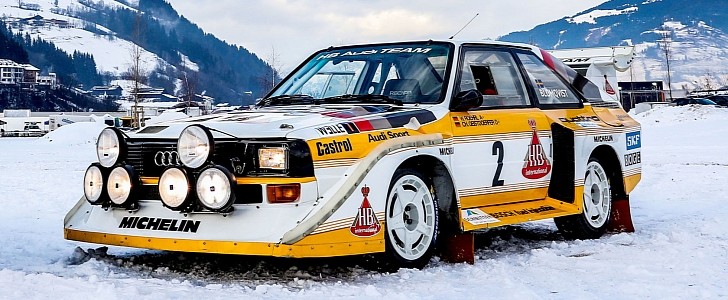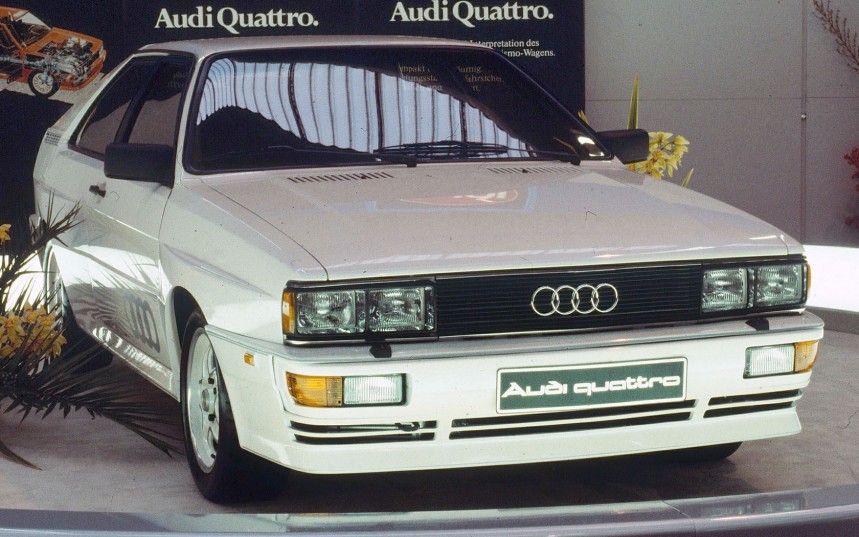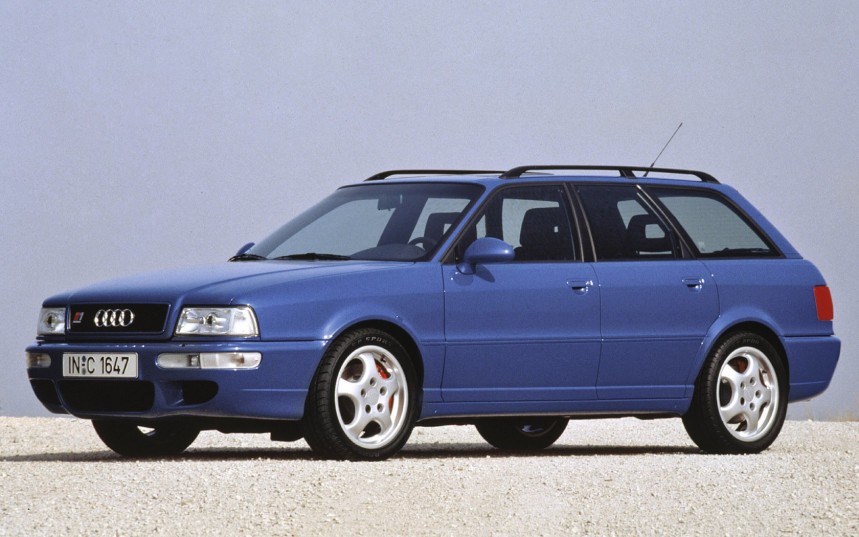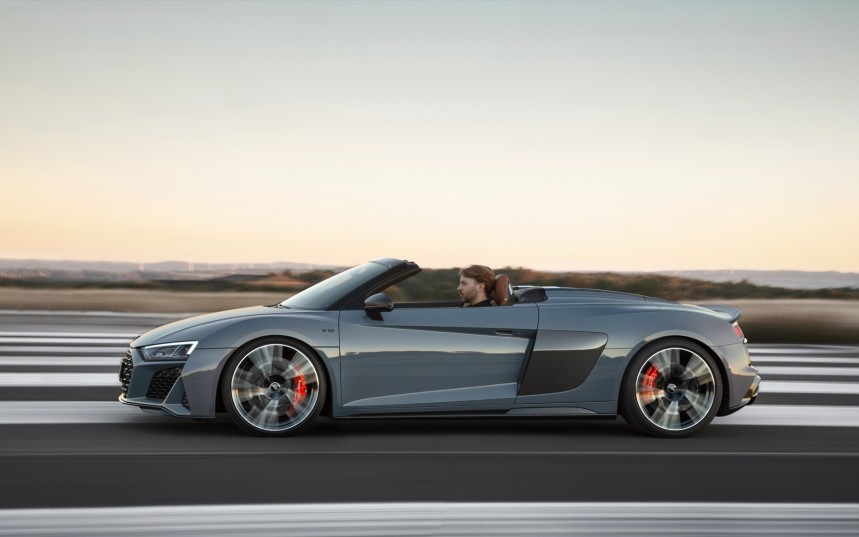The quattro system has become synonymous with Audi ever since it was introduced 40 years ago. Instant success in motorsport led to the decision to implement this system on almost all following Audi models, a move that revolutionized the industry.
It all started in the winter of 1976-77, when a group of Audi engineers were performing various endurance tests in a remote region of Sweden.
Accompanying the front-wheel driven Audi prototypes, which were struggling in the deep snow, was a Volkswagen Type 183 - commonly known as the Iltis (German for polecat).
Despite its modest 75 hp (55 kW) output, the all-terrain vehicle easily outperformed the much more powerful Audis.
Inspired by this, upon returning to Germany, the engineers led by Jörg Bensinger started developing a permanent all-wheel-drive system that would power the new generation of Audi road cars and racing machines.
Their solution was the hollow shaft, a drilled-out, 263 mm (10.4 in) secondary shaft in the transmission, through which power flowed in two directions, driving the housing of the center differential from its rearmost end.
The differential sent 50% of the power to the rear axle, which was equipped with a locking differential. The other half of the torque was transferred to the front axle’s differential.
The all-wheel-drive the engineers created was virtually tension-free, light, compact, and efficient, while being able to run without the use of a heavy transfer case.
It was the beginning of a new era for all-wheel-drive, which could now suit sporty automobiles instead of being limited to heavy, slow-moving utilitarian vehicles.
The first car to feature this technology was the Audi Quattro, which was first revealed at the 1980 Geneva Motor Show. It was based on the Volkswagen Group B2 platform, which it shared with the Audi 80 and VW Passat.
That same year, the car made its debut in the World Rally Championship, taking advantage of the recent rule change that allowed all-wheel-drive cars to enter the competition.
The competition was no match for the superior quattro cars and they would go on to win two consecutive drivers’ titles in 1983 and 1984, and the manufacturers' titles in 1982 and 1984.
Rallying would never be the same again, as most manufacturers then started developing all-wheel-drive cars in an attempt to beat the quattro.
Ever since those days, the system has continually evolved. The second generation quattro debuted in 1988, introducing a newly developed Torsen (torque sensing) central differential with a 50:50 'default' split that could automatically deliver up to 75% of torque transfer to either axle and was used on many Audi models, like the legendary RS2 Avant.
The third generation was developed specifically for the Audi V8 and was used from 1988 to 1994. On manual transmission models, it worked using a central Torsen differential that was aided by a similar one placed on the rear axle.
Automatic transmission V8s used the same rear Torsen differential that was aided by a planetary gear central differential with an electronically controlled multi-plate locking clutch.
The manually locking rear differential from the earlier generations was replaced in the fourth generation quattro system with a conventional open differential, which featured an Electronic Differential Lock (EDL). This system graced Volkswagen Group vehicles from 1995 to 2006.
Permanent asymmetric four-wheel-drive was introduced in 2006 for the fifth generation of the system on the B7 Audi RS4 using a type 3 Torsen differentialm, which featured a 40:60 front-rear power split. With the aid of the ESP unit, up to 100% of the torque could be transferred to one axle.
In 2008, torque vectoring was introduced using a Magna Powertrain-designed rear axle differential dubbed the Sport Differential. It selectively distributed torque to the rear wheels generating a yaw moment, which improved the handling and stability of the vehicle when it oversteered or understeered.
The sixth generation debuted in the 2010 RS5 and replaced the Torsen type 3 central differential with an Audi-developed Crown Gear differential.
With the use of this innovative differential up to 70% of the torque could be directed to the front wheels or up to 85% to the rear, whenever necessary.
The transcendence of quattro into the era of electric all-wheel-drive started in 2019, with the introduction of the e-tron and the e-tron Sportback. Electric motors drive the front and rear axles, working together with drive control units that manage the ideal distribution of torque.
In the past 40 years, the system revolutionized both Audi road and racing cars, becoming arguably the most well-known all-wheel-drive system in the industry.
Accompanying the front-wheel driven Audi prototypes, which were struggling in the deep snow, was a Volkswagen Type 183 - commonly known as the Iltis (German for polecat).
Despite its modest 75 hp (55 kW) output, the all-terrain vehicle easily outperformed the much more powerful Audis.
Inspired by this, upon returning to Germany, the engineers led by Jörg Bensinger started developing a permanent all-wheel-drive system that would power the new generation of Audi road cars and racing machines.
Their solution was the hollow shaft, a drilled-out, 263 mm (10.4 in) secondary shaft in the transmission, through which power flowed in two directions, driving the housing of the center differential from its rearmost end.
The differential sent 50% of the power to the rear axle, which was equipped with a locking differential. The other half of the torque was transferred to the front axle’s differential.
The all-wheel-drive the engineers created was virtually tension-free, light, compact, and efficient, while being able to run without the use of a heavy transfer case.
It was the beginning of a new era for all-wheel-drive, which could now suit sporty automobiles instead of being limited to heavy, slow-moving utilitarian vehicles.
The first car to feature this technology was the Audi Quattro, which was first revealed at the 1980 Geneva Motor Show. It was based on the Volkswagen Group B2 platform, which it shared with the Audi 80 and VW Passat.
The competition was no match for the superior quattro cars and they would go on to win two consecutive drivers’ titles in 1983 and 1984, and the manufacturers' titles in 1982 and 1984.
Rallying would never be the same again, as most manufacturers then started developing all-wheel-drive cars in an attempt to beat the quattro.
Ever since those days, the system has continually evolved. The second generation quattro debuted in 1988, introducing a newly developed Torsen (torque sensing) central differential with a 50:50 'default' split that could automatically deliver up to 75% of torque transfer to either axle and was used on many Audi models, like the legendary RS2 Avant.
Automatic transmission V8s used the same rear Torsen differential that was aided by a planetary gear central differential with an electronically controlled multi-plate locking clutch.
The manually locking rear differential from the earlier generations was replaced in the fourth generation quattro system with a conventional open differential, which featured an Electronic Differential Lock (EDL). This system graced Volkswagen Group vehicles from 1995 to 2006.
Permanent asymmetric four-wheel-drive was introduced in 2006 for the fifth generation of the system on the B7 Audi RS4 using a type 3 Torsen differentialm, which featured a 40:60 front-rear power split. With the aid of the ESP unit, up to 100% of the torque could be transferred to one axle.
In 2008, torque vectoring was introduced using a Magna Powertrain-designed rear axle differential dubbed the Sport Differential. It selectively distributed torque to the rear wheels generating a yaw moment, which improved the handling and stability of the vehicle when it oversteered or understeered.
With the use of this innovative differential up to 70% of the torque could be directed to the front wheels or up to 85% to the rear, whenever necessary.
The transcendence of quattro into the era of electric all-wheel-drive started in 2019, with the introduction of the e-tron and the e-tron Sportback. Electric motors drive the front and rear axles, working together with drive control units that manage the ideal distribution of torque.
In the past 40 years, the system revolutionized both Audi road and racing cars, becoming arguably the most well-known all-wheel-drive system in the industry.












